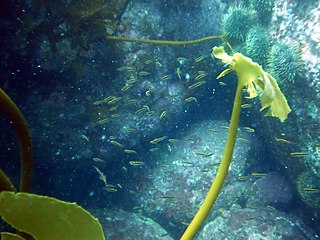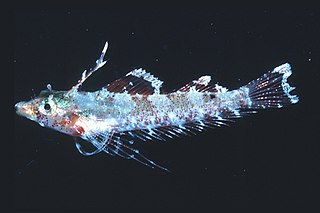
The spectacled triplefin, Ruanoho whero, is a triplefin in the genus Ruanoho. It is commonly found around New Zealand from depths of a few metres to about 30 m, most common in reef areas of broken rock. Its length is between 4 and 8 cm and its head is flattened with large eyes surrounded by a dark band giving rise to its common name. The head and fins have a pattern of fine blue lines. Its large pectoral fins are used as props when resting on the bottom where it spends most of its time.

Yaldwyn's triplefin, Notoclinops yaldwyni, is a fish of the genus Notoclinops, found around the North Island of New Zealand from low water to depths of about 5 metres, most common in reef areas of broken rock, but nowhere common. Its length is between 4 and 8 centimetres. It is a pale yellow-brown with a faint orange tinge to the head, and two or three rows of small black dots on the flanks.

The oblique-swimming triplefin, Forsterygion maryannae, is a triplefin, found along the north east coast of the North Island of New Zealand from depths of about 5 m to 50 m. They are the only triplefins not to spend most of their time resting on the bottom, instead swimming in loose schools of up to hundreds of individuals above rocky reefs. When swimming their head is higher than the tail, giving rise to their common name.
The scaly-headed triplefin, Karalepis stewarti, is a triplefin, the only species in the genus Karalepis. It is endemic to New Zealand where it is found around North Island, South Island, the Three Kings Islands, Snares Island and Stewart Island. It is a nocturnal species It occurs at depths of about 5 to 30 metres, in reef areas of broken rock. The specific name honours Andy Stewart of the Department of Fishes at the National Museum of New Zealand.

Bellapiscis lesleyae, the mottled twister, is a triplefin of the family Tripterygiidae, commonly found around the coast of New Zealand in rock pools and down to depths of about 5 m in reef areas of broken rock. Its length is up to 6 cm. The specific name of this blenny honours the New Zealand marine biologist Lesley Bolton who helped Hardy collect fishes in rockpools on the coast of New Zealand, including the type of this species.
The cryptic triplefin, Cryptichthys jojettae, is a triplefin of the family Tripterygiidae, the only member of the genus Cryptichthys, found around the coast of New Zealand. It length is up to 6 cm. The specific name honours a former staff member at the National Museum of New Zealand, Jorjette Drost, who participated in collecting specimens with Hardy.

Forsterygion is a genus of triplefins in the family Tripterygiidae native to coastal New Zealand, but also introduced to Tasmania, Australia.

The largemouth triplefin, Ucla xenogrammus, is a fish of the family Tripterygiidae and only member of the genus Ucla, found in the Pacific Ocean from Viet Nam, the Philippines, Palau and the Caroline Islands to Papua New Guinea, Australia, and the Solomon Islands, Fiji, Tonga, east to American Samoa and Rapa Iti, at depths of between 2 and 41 metres. Its length is up to about 47 millimetres (1.9 in). The generic name was coined by ichthyologist Richard Heinrich Rosenblatt in his unpublished dissertation of 1959 from the University of California Los Angeles and its is the initials of that institution, it was formally applied by Holleman in 1993.
Ceratobregma helenae, known commonly as the Helen's triplefin, is a species of triplefin blenny. It has an Indo-Pacific distribution from Christmas Island to Samoa, north to Taiwan and south to south eastern Australia. The species is named after Wouter Holleman's wife, Helen.

Enneanectes jordani, known commonly as the redbelly triplefin and the mimic triplefin, is a species of triplefin blenny from the northern Caribbean Sea and the Gulf of Mexico south as far as Venezuela. The specific name honours the American ichthyologist David Starr Jordan (1851-1931). Some authorities consider the synonym Enneanectes pectoralis to be a valid species.
Enneapterygius clarkae, the barred triplefin, is a species of threefin blenny in the genus Enneapterygius. It was described by Wouter Holleman in 1982, and was given its species epithet in honour of American ichthyologist Eugenie Clark (1922-2015) It is a tropical blenny known from the Indian Ocean, and has been described from the Red Sea to Natal, South Africa. Male barred triplefins can reach a maximum length of 2.5 centimetres.

Enneapterygius tutuilae, known commonly as the high-hat triplefin or rosy cheek threefin, is a species of triplefin blenny in the genus Enneapterygius. It was described by David Starr Jordan and Alvin Seale in 1906. This species occurs from the eastern Indian Ocean around the Cocos (Keeling) Islands east to French Polynesia. Its specific name refers to the Samoan island of Tutuila where the type was collected.
Enneapterygius larsonae, known commonly as the Western Australian black-head triplefin, is a species of triplefin blenny in the genus Enneapterygius. It was described by the German ichthyologist Ronald Fricke in 1994. The specific name honours Helen K. Larson, the Curator of Fishes at the Museum and Art Gallery of the Northern Territory in Darwin, Australia, who collected the type.

Enneapterygius mirabilis, the miracle triplefin, is a species of triplefin blenny in the genus Enneapterygius. It was described by Ronald Fricke in 1994 who gave it the specific name mirabilis, meaning "admirable", because its notable large pectoral fins and first dorsal fin were pretty.

Helcogramma hudsoni, known commonly as the Hudson's triplefin, is a species of triplefin blenny in the genus Helcogramma. It was described by David Starr Jordan and Alvin Seale in 1906, the specific name honouring the illustrator of their monograph on Samoan fishes, R.L. Hudson. This species is found in the western Pacific Ocean where it has been recorded from the Izu Islands, Ryukyu Islands, Savo Island, New Caledonia, Vanuatu, Fiji, and Samoa.
Cunningham's triplefin is a species of triplefin blenny in the genus Helcogrammoides. It was described by Frederik Adam Smitt in 1898, who named it in honour the Scottish naturalist Robert Oliver Cunningham (1841-1918), who had collected specimens of this fish from Puerto Madryn in 1868 but was unable to identify them. This species has been found in Peru, near Lima, Chile, Puerto Madryn in Argentina and the Falkland Islands.
Norfolkia leeuwin, known commonly as the Leeuwin triplefin, is a species of triplefin blenny in the genus Norfolkia. It was described by Ronald Fricke in 1994. This species is found in the southern part of the coast of Western Australia from the Houtmon's Abrolhos Islands to the Recherche Archipelago. It is found in rocky reefs. Its specific name references the Leeuwin Current which influences the coastal areas in which this fish occurs.

Norfolkia squamiceps, known commonly as the Scalyhead triplefin, is a species of triplefin blenny in the genus Norfolkia. It was described by Allan Riverstone McCulloch and Edgar Ravenswood Waite in 1916. Under the synonym Norfolkia lairdi it was the type species of Fowler's new genus. This species has been recorded from off Queensland, Norfolk Island, Lord Howe Island, New Caledonia and the Loyalty Islands. The adults occur in tidal pools among areas of coral reef.
Norfolkia thomasi, known commonly as the Thomas' triplefin, is a species of triplefin blenny in the genus Norfolkia. It was described by Gilbert Percy Whitley in 1964, naming it in honour of Leonard Rees Thomas who organised the Australian Museum's 1962 Swain Reefs Expedition. The hemispherical eggs of the Thomas' triplefin are covered in sticky threads that help anchor them in the algae on their nesting sites. This adaption helps insure the safety of the eggs. One the eggs hatch the larvae that emerge are planktonic and they stick to shallow waters near the shore. The matured Thomas' triplefin then ventures out into the coral reef and intertidal pools. This species is found in the western Pacific Ocean from the Ryukyu Islands to the Tuamoto Archipelago, in Australia it is distributed from the northern Great Barrier Reef south to Byron Bay, New South Wales.
Springerichthys kulbickii, known commonly as the Kulbicki's triplefin, is a species of triplefin blenny in the genus Springerichthys. It was described by Ronald Fricke and John E. Randall in 1994, honouring the fish ecologist reef-fish ecologist Michel L. Kulbicki of L'Office de la Recherche Scientifique et Technique d’Outre-Mer in Nouméa, who collected type in New Caledonia, in its specific name. Kulbicki's triplefin is found in the southwestern Pacific Ocean from Queensland, Australia across the central Pacific to the Samoa, where it is found on rocky and coral reefs down to 15 metres (49 ft) in depth.











